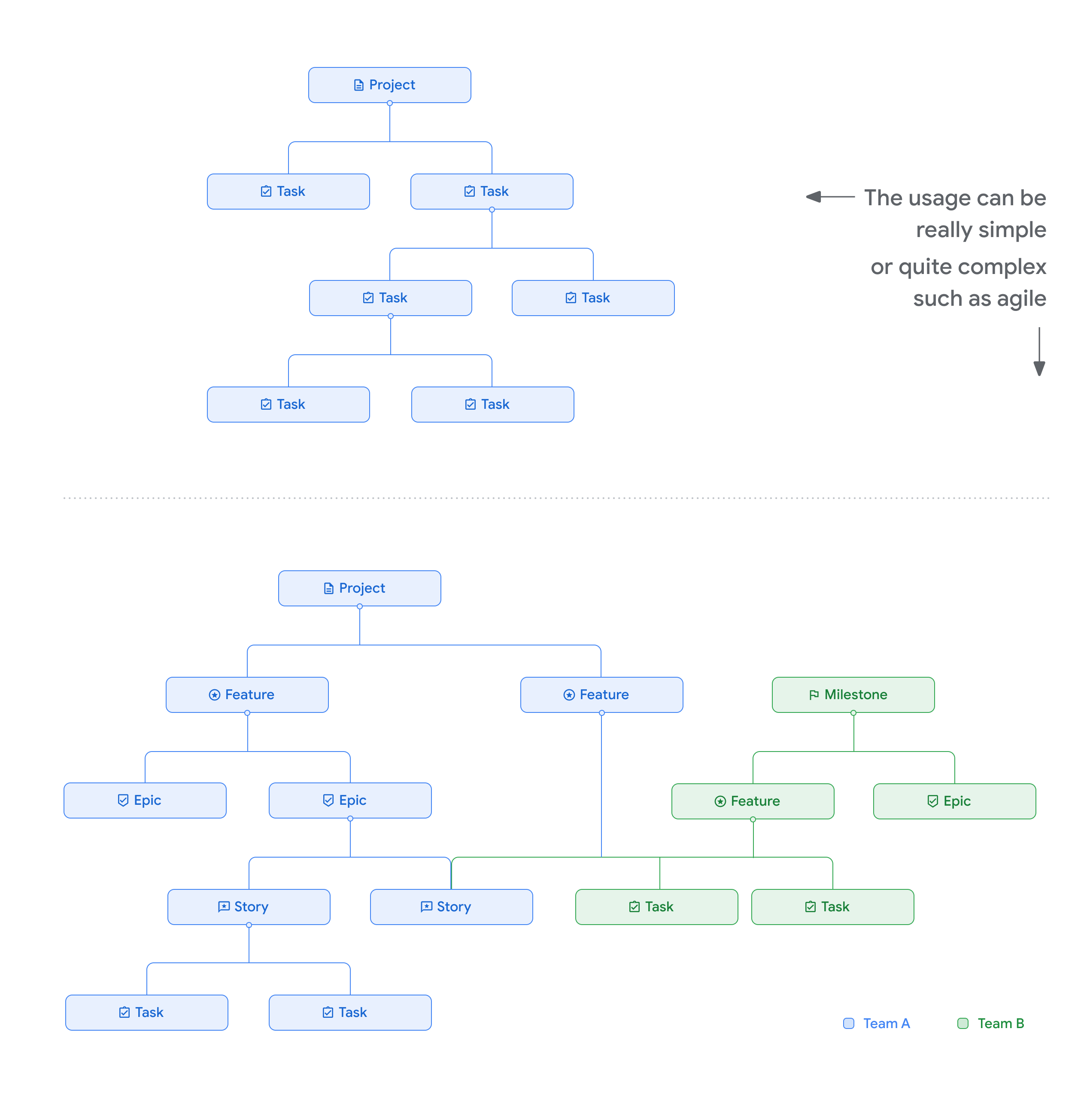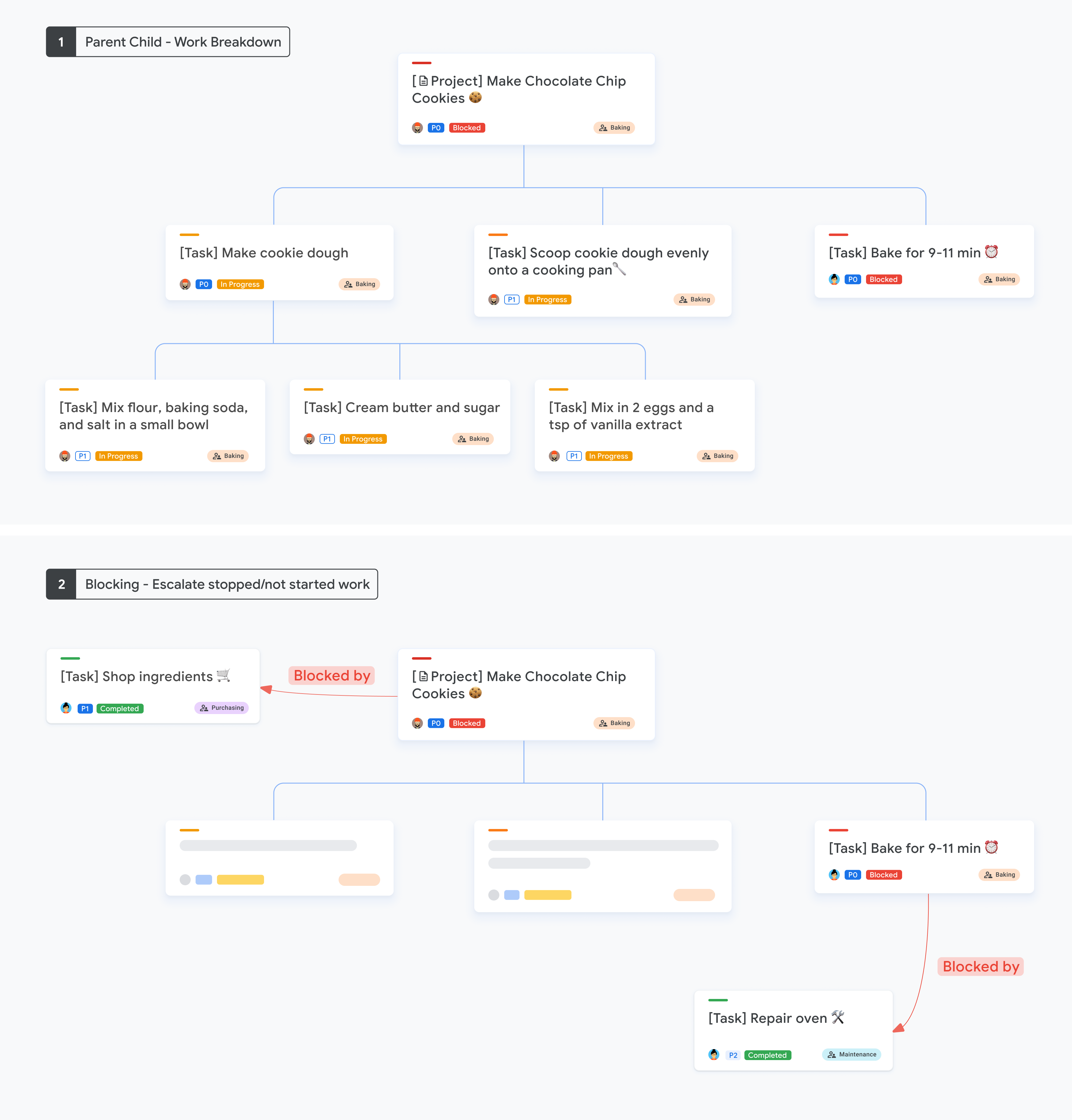Ebeveyn-Çocuk İlişkileri
Koleksiyonlar ile düzeninizi koruyun
İçeriği tercihlerinize göre kaydedin ve kategorilere ayırın.
Google Sorun Takip Aracı, üst-alt ilişkilerini destekler. Ebeveyn-çocuk ilişkisi genellikle belirli bir çalışma kapsamındaki iş dökümünü temsil etmek için kullanılır. Bir ebeveynin birden fazla çocuğu, bir çocuğun da birden fazla ebeveyni olabilir.
Üst-alt ilişkisi aşağıdaki özelliklere sahiptir:
| Özellik |
Ayrıntılar |
| İlişki |
N:N |
| Sipariş verme |
Bir ebeveyn altındaki çocukların sıralanması desteklenir. |
| Döngü algılama |
Döngüsel bağımlılıklar sistem tarafından engellenir. |
| Doğrudan alt öğelerin maksimum sayısı |
500 |
| Maks. ata |
1000 |
Örnekler
Aşağıdaki grafikte bazı örnek üst-alt ilişkileri gösterilmektedir.

Üst-alt hesap ilişkileri ve engelleme
Üst-alt ilişkileri kullandığınızda mevcut Engelleme ve Engelleyen ilişkileri desteklenmeye devam eder. Ebeveyn-çocuk ilişkilerini engellemeyle birleştirirken:
- İşi daha küçük birimlere bölmek için ebeveyn-çocuk ilişkilerini kullanın.
- Zamanlama ve sıra önemli olduğunda ve durdurulan veya başlatılmayan işleri üst birime iletme konusunda kullanıcı arayüzünde net göstergeler sağlamak istediğinizde engelleme ve tarafından engellendi seçeneklerini kullanın.
Aşağıdaki grafikte, üst öğe-alt öğe ve engelleme çalışması dökümlerine örnekler verilmiştir.

Tüm hakları saklıdır. Java, Oracle ve/veya satış ortaklarının tescilli ticari markasıdır.
Son güncelleme tarihi: 2025-07-25 UTC.
[null,null,["Son güncelleme tarihi: 2025-07-25 UTC."],[[["\u003cp\u003eGoogle Issue Tracker enables the creation of parent-child relationships to represent the hierarchical breakdown of work within a project.\u003c/p\u003e\n"],["\u003cp\u003eIssues can have multiple parents and children, but the system prevents circular dependencies and limits the number of direct children to 500 and total ancestors to 1000.\u003c/p\u003e\n"],["\u003cp\u003eWhile parent-child relationships are ideal for structuring tasks, "Blocking" and "Blocked by" relationships should be used to indicate critical timing and sequencing dependencies.\u003c/p\u003e\n"],["\u003cp\u003eUsers are encouraged to leverage both relationship types to manage work effectively, using parent-child for work breakdown and blocking for highlighting time-sensitive dependencies.\u003c/p\u003e\n"]]],[],null,["# Parent-Child Relationships\n\nGoogle Issue Tracker supports parent-child relationships. A parent-child\nrelationship is typically used to represent the breakdown of work within a given\neffort. A parent can have multiple children, and a child can have multiple\nparents.\n\nThe parent-child relationship has the following characteristics:\n\n| Characteristic | Details |\n|-------------------------|----------------------------------------------------|\n| **Relationship** | N:N |\n| **Ordering** | Ordering of children within a parent is supported. |\n| **Cycle detection** | Cyclic dependencies are prevented by the system. |\n| **Max direct children** | 500 |\n| **Max ancestors** | 1000 |\n\nExamples\n--------\n\nThe following graphic shows some sample parent-child relationships.\n\nParent-child relationships and blocking\n---------------------------------------\n\nThe existing **Blocking** and **Blocked by** relationships are still supported\nwhen you use parent-child relationships. When you're combining parent-child\nrelationships with blocking:\n\n- Use **parent-child** relationships to break down work into smaller units.\n- Use **blocking** and **blocked by** when timing and sequence are critical, and you want to provide clear indications in the UI to escalate stopped or not started work.\n\nThe following graphic shows examples of parent-child and blocking work\nbreakdowns."]]
![]()
![]()
